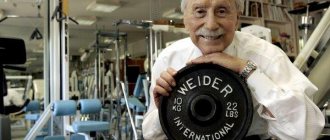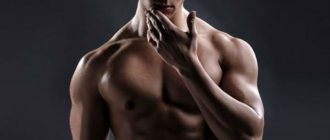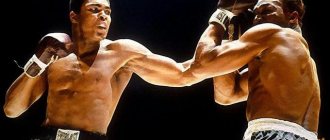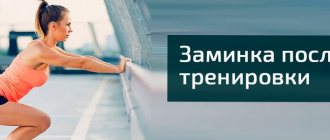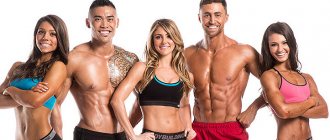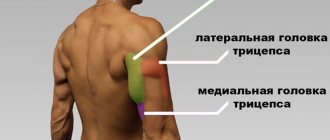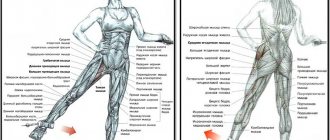Hi guys! Now many of you work out in elite gyms and expensive fitness clubs. This is good! Keep it up! But there are also quite a few people who remember a time when all this did not exist.
When bodybuilders huddled in crowds, they often huddled in cramped gyms somewhere in the basement. This persistent smell of sweat and slightly rusty iron - yes, they remember all this.
In those days and in those circles they knew who Joe Weider was. And those who had a bodybuilding textbook from Vader even knew that there are a lot of bodybuilding training “tricks” that can not only diversify the workout, but also give a powerful impetus to muscle development after their use.
Bodybuilding to this day uses special training principles developed by Joe Weider, the founder of modern bodybuilding. These principles can greatly help an athlete in his progress. These are all important subtleties.
Joe Weider's training principles will be described here for intermediate, experienced and newbies. A beginner in this sense is someone who has already been training for 6-9 months.
If you are still a complete beginner, then you can simply familiarize yourself with these principles and do not rush to apply them until you have completed the initial training in bodybuilding and trained in the initial programs for beginners.
If you are an experienced athlete who has been training for 1 year or more, then this information may be useful to you. By applying these principles, a bodybuilder will diversify his training and take it to a completely different level, a higher level. You will feel the real taste of training and its meaning.
General information
Joe Weider Canada Born: - November 29, 1919 Height: - 180 cm Weight in the off-season: - 84 kg *
Joe Weider was born on November 29, 1919 in Montreal. At an early age he began training . The design of his first boom consisted of automobile wheels and a locomotive axle. At age 17, Joe published Your Physique magazine. It talks about Joe's own training methods and how to build muscle the right way. Afterwards the magazine will be renamed “Muscle Builder”, and even later “Muscle & Fitness”. After the war, Joe Weider and his brother Ben began actively promoting bodybuilding. The Weider brothers became the founders of the International Federation of Bodybuilders in 1946. 19 years later Joe founded the Mr. Olympia competition , which is still the most significant competition for bodybuilders. These competitions were created to continue the training of athletes who won the Mr. Universe competition. Joe Weider trained such famous bodybuilders as Arnold Schwarzenegger, Frank Zane, Lee Haney, Larry Scott, Franco Colombo and Louis Ferrigno. As soon as bodybuilding gained popularity among women, Weider created the Miss Olympia competition . The first competitions in women's sports took place in 1980. Joe Table's other accomplishments include founding Weider Publications, which produces fitness magazines such as Muscle Power, Mr. America, Men's Fitness, Shape, Prime Health and Fitness, Flex, and Cooks." In the late 90s, the publishing house was bought by. In addition to all of the above, Joe Weider founded a series of books in which he talked about his training methods , called “The Weider Body Building System.”
Read also[edit | edit code]
- Sports training
- Goals and objectives of sports training
- Planning a sports training
- Weider's principles
- Effective principles for gaining muscle mass
- General and special physical training
- Sports training methods
- Concentrated One-Directional Training Model
- Multi-objective block periodization model
- Periodization for endurance training
- Periodization and planning of training in sports games
- Planning and periodizing strength and power training
Set of exercises
Joe Weider's set of exercises for beginners:
This program is designed for 2 months of training . Classes are held 3 times a week , without changing or adding anything. Press. Starting position: lying down. Raising the body. 2 sets of 20-30 repetitions. Barbell bench press. Starting position: lying on a bench. 3 sets of 8-12. Barbell row. Starting position: standing with a narrow grip. 2 sets of 8-12 reps. Pull-downs for the head, 3 sets of 8-12 reps. Dumbbell presses. Alternating raises while standing. 3 sets of 8-12 reps. Leg extension. The starting position is sitting on a special machine. 2 sets of 10-15 repetitions. Exercises for the triceps muscles. Hand presses down on the upper block. 2 sets of 8-12 reps. Exercises for leg muscles. Presses on a special machine. 3 sets of 10-15 repetitions. Curling arms with a barbell. 3 sets of 10-15 repetitions. Calf raises with a barbell on your back in a special device. 3 sets of 15-20 repetitions.
More details about each exercise are discussed here.
Joe Weider's set of exercises for intermediate athletes:
Monday
- Wide grip bench press 3 sets of 9 reps.
- Standing barbell chest press 3 sets of 9 reps.
- Raising arms with dumbbells while lying head up at an angle of 45 degrees.
- Barbell rows to the chin with a close grip/bent over 3 x 9 reps.
- Standing lateral raises with dumbbells, 3 sets of 9 reps.
- Standing barbell curls 3 sets of 9 reps.
- Raising the torso to the legs from a lying position, 3 sets of 30-50.
- Reclining dumbbell curls on an incline bench, 45 degree angle, 3 sets of 9 reps.
- “French” standing barbell press 3 sets of 9 reps.
- Side bends with dumbbells in hands, 3 sets of 30-50.
Tuesday
- Back squats 3 sets of 9 reps.
- Shoulder Raises with Barbell in Hands Down 3 sets of 9 reps.
- Deadlift 3 sets of 9 reps.
- Leg straightening, sitting on a special machine, 3 sets of 9 repetitions.
- Single leg calf raises 3 sets of 9 reps.
- Wrist curls with an under/overhand grip on the barbell, 3 sets of 30-50 reps.
- Lying leg curls on a special machine 3 sets of 9 repetitions.
- Incline leg raises 3 sets of 25 reps.
Thursday
- Close grip/incline bench press 45 degrees 3 sets of 9 reps.
- Pullover lying over a bench with a dumbbell 3 sets of 9 reps.
- Bent-over dumbbell raises 3 sets of 9 reps.
- Incline barbell bench press 45 degrees/seated overhead 3 sets of 9 reps.
- Bent-over barbell rows 3 sets of 9 reps.
- Seated dumbbell curls with the elbow resting on the inner thigh, 3 sets of 9 repetitions.
- “French” seated dumbbell press, 3 sets of 9 reps.
- Seated dumbbell curls. bench 3 sets of 9 reps.
- Side bends with one dumbbell in hand, 3 sets of 30-50 repetitions.
- Torso raises from a lying position 3 sets of 30-50 repetitions.
Friday
- Back squats 3 sets of 9 reps.
- Extension/bending of legs on a special machine 3 sets of 9 repetitions.
- One-arm dumbbell rows 3 sets of 9 reps.
- Back squats, barbell on back 3 sets of 9 reps.
- Shoulder Raises with Barbell in Hands Down 3 sets of 9 reps.
- Calf raises with a barbell on the back, 3 sets of 15 reps.
- Deadlift 3 sets of 9 reps.
- Torso raises from a lying position 3 sets of 30-50 repetitions.
- Reverse grip barbell curls 3 sets of 15 reps.
- Pulling your knees to your chest while hanging on the bar, 3 sets of 30-50 repetitions.
Joe Weider does not recommend sticking to any preset weights. At times you will have more or less energy during a session and will be able to lift more or less weight.
Speed of movement
Scientific research has shown that exercises that start with a sharp jerk and end with a quick lowering of the weight are not effective. The muscle remains weak and undeveloped at its attachment points, and only its middle part acquires any strength.
For full muscle development, a slow pace is necessary. You need at least two seconds to lift the weight to its extreme position, and another two to maintain a distinct pause. Lowering weights requires special discussion.
Did you know that a muscle works in different strength modes during an exercise? When you lift the barbell to the top extreme position during a biceps curl, this is the so-called positive or overcoming mode. When you lower it, it is negative or inferior. In the first mode, the muscle develops less power than in the second, so you get the feeling that raising the barbell is much more difficult than lowering it.
Since it is “easier” to lower the weight on the muscle, it needs to be loaded more thoroughly. Therefore, I advise you to extend the second phase of the exercise to 3-3.5 seconds.
Training principles
- System of several approaches. This system is performed with each exercise in order to completely exhaust the muscle (group of muscles) being trained, as well as to ensure their stimulation and maximum development.
- The principle of shocking muscles. You should never let your muscles adapt to a training program . In order for muscles to grow, they need to be kept under constant stress. Therefore, it is necessary to change the number of approaches and repetitions.
- The principle of muscle isolation. Muscles can work in isolation from each other. If you want to develop a specific muscle, you need to isolate it from other muscles. This can be achieved using an anatomical position.
- The principle of priority. Give priority to your weakest muscle and start training it first in each session while your energy is at its maximum.
- The "pyramid" principle. You should not start working with heavy weights. The work should start with a small weight, and then go to increase it. Start your workout with a weight of 50% of your maximum and complete the exercise for 15 repetitions. Then increase the weight and do 10-12 repetitions. So increase the weight of the weights to 80%, and repeat the exercises 5-6 times.
- The principle of constructing training cycles. At the initial stage, you prepare a training program and build muscle tissue. At the next stage, it is necessary to increase the number of repetitions and reduce pauses between approaches.
- The principle of "cheating". “Cheating” is not considered as a way to relieve stress from a muscle, but rather to increase it. Therefore, this technique should be used to perform additional repetitions or to help the working muscles by recruiting muscles from another part of the body.
- The "rest-pause" principle. If the weight of your weights is so heavy that you cannot perform more than two or three repetitions, you need to rest your muscles for 30-45 seconds and do a few more repetitions.
- The principle of double division. Most athletes train one or two body parts in the morning and then return to the gym in the afternoon or evening to work a couple more muscles.
These are just a few of Joe Wade's most commonly used training principles.
Pyramid principle
As you increase the weight of the apparatus, you can decrease the number of repetitions, and vice versa. Or you can increase the weight, leaving the number of repetitions unchanged.
There are five types of pyramids:
- Classic.
- Truncated.
- Reverse.
- Ascending semi-pyramid.
- Descending semi-pyramid.
Using the bench press as an example, it looks like this.
1. Classic.
- The first approach is 30 kg, 10 repetitions.
- Second set - 40 kg, 8 reps.
- Third set - 50 kg, 6 reps.
- The fourth approach is 60 kg, 4 repetitions.
- Fifth set - 80 kg, 2 reps.
- Sixth approach - 100 kg, 1 repetition.
2. Truncated.
- The first approach is 30 kg, 10 repetitions.
- Second set - 40 kg, 8 reps.
- Third, fourth, fifth approaches - 50 kg, 6 repetitions.
3. Reverse.
- The first approach is 100 kg, 1 repetition.
- Second set - 80 kg, 3 reps.
- Third set - 60 kg, 5 reps.
4. Ascending semi-pyramid.
- The first approach is 30 kg, 10 repetitions.
- Second set - 40 kg, 8 reps.
- Third, fourth approaches - 50 kg, 6 repetitions.
- Fifth set - 40 kg, 8 reps.
- Sixth set - 30 kg, 10 reps.
5. Descending semi-pyramid.
It is performed as an ascending exercise, but goes from the maximum weight to the minimum and again to the maximum.
Nutrition
Whatever sport you choose, 60% of success will depend on proper nutrition. Here are three basic rules that must be followed according to Joe Weider :
- It is necessary to carefully monitor the quality of food consumed . It is important that the diet includes all the main components.
- Properly distribute your calorie sources : 60% - carbohydrates . Moreover, it is advisable to eat natural carbohydrates. They give our body the necessary energy that maintains our vitality throughout the day. They are also necessary for restoring glycogen in muscles. 20-25% – plant and animal proteins (preferably with less fat). Protein is needed to produce energy and repair muscle fibers that are stretched during training, and also allows you to build muscle mass faster. 25-30% - fats. They maintain normal blood viscosity. In addition, they promote the production of hormones and the supply of vitamins and energy. In addition to all of the above, in between meals, you need to eat a portion of vegetables and fruits, and also drink 2-3 liters of water per day .
- Nutrition should suit your body type . Beginners need to reduce the amount of fat and, conversely, increase their protein intake.
We discussed this in more detail in the following articles:
- Fitness and nutrition;
- Metabolism;
- What you need and healthier to eat for breakfast;
- All about calories.
Basic principles of sports training
GOAL, OBJECTIVES, MEANS, METHODS AND BASIC PRINCIPLES OF SPORTS TRAINING
Plan
1. Goals and objectives of sports training
2. Sports training aids
3. Sports training methods
3. Basic principles of sports training
1. Goals and objectives of sports training
The goal of sports training is to achieve the highest possible level of technical, tactical, physical and mental preparedness for a given individual, determined by the specifics of the sport and the requirements for achieving the highest possible results in competitive activity.
The main tasks solved during the training process are the following:
— mastering the technique and tactics of the chosen sport;
— ensuring the necessary level of development of motor qualities, the capabilities of the functional systems of the body that bear the main load in this sport;
— education of the necessary moral and volitional qualities;
— ensuring the necessary level of special mental preparedness;
— acquisition of theoretical knowledge and practical experience necessary for successful training and competitive activities;
— comprehensive improvement and manifestation of various aspects of an athlete’s preparedness in competitive activity.
General preparatory
auxiliary,
specially-preparatory
competitive.
General preparatory exercises include exercises that serve the comprehensive functional development of the athlete’s body. They can both correspond to the characteristics of the chosen sport, and be in a certain contradiction with them (when solving the problems of comprehensive and harmonious physical education).
For example,
General preparatory exercises may include elements of gymnastics, acrobatics, and sports games.
Auxiliary exercises involve motor actions that create a special foundation for subsequent improvement in a particular sports activity.
For example,
auxiliary exercises may include means that help increase maximum strength, strength endurance and flexibility when working in the gym, means borrowed from other sports and aimed at increasing aerobic capabilities - cross-country running, skiing, rowing.
Special preparatory exercises occupy a central place in the training system of qualified athletes and cover a range of means that include elements of competitive activity, as well as actions close to them in form, structure, as well as the nature of the manifested qualities and activity of the functional systems of the body.
For example,
for an athlete specializing in swimming, special training - swimming sections of the distance using the main and additional swimming methods, swimming with only arms or legs, with additional weights and braking devices, etc.
Competitive exercises involve performing a set of motor actions that are the subject of sports specialization, in accordance with the existing competition rules.
For example, also for an athlete specializing in swimming, a competitive exercise will be swimming the main or adjacent distance in accordance with the rules of the competition;
This division is very arbitrary, the boundaries between the selected groups of exercises are unclear, and, in fact, the means, both in their form and structure, and in the characteristics of their effect on the body, smoothly move from one group to another.
Sports training means are also divided according to the direction of impact. In this case, it is possible to allocate funds primarily related to the improvement of various aspects of preparedness - technical, tactical, etc., as well as aimed at the development of individual motor qualities.
3.
Methods of sports training The
methods used in sports training should be understood as the methods of work of the coach and the athlete, with the help of which mastery of knowledge, skills and abilities is achieved, the necessary qualities are developed, and a worldview is formed.
For practical purposes, all methods are conventionally divided into three groups:
- verbal,
- visual and
- practical.
When selecting methods, care should be taken to ensure that they strictly correspond to the assigned tasks, general didactic principles, as well as special principles of sports training, age and gender characteristics of athletes, their qualifications and preparedness.
Verbal methods used in sports training include story, explanation, lecture, conversation, analysis and discussion. (in combination with visual ones, i.e., for example, you verbally explain, visually show)
Visual methods used in sports practice are diverse and largely determine the effectiveness of the training process. First of all, these include a methodologically correct demonstration of individual exercises and their elements, which is usually carried out by a coach or qualified athlete.
In sports practice, especially in recent years, auxiliary means of demonstration are widely used - educational films, video tape recordings, mock-ups of playing fields and fields for demonstrating tactical schemes, electronic games. Orientation methods are also widely used. Here it is necessary to distinguish between the simplest landmarks that limit the direction of movement, the distance covered, etc., and more complex ones - light, sound and mechanical leading devices, including those with program control and feedback. These devices allow the athlete to obtain information about the tempo-rhythm, spatial and dynamic characteristics of movements, and sometimes provide not only information about movements and their results, but also forced correction.
Methods of practical exercises can be divided into two main groups:
1) methods primarily aimed at mastering sports techniques, i.e., at developing motor skills and abilities characteristic of a chosen sport (for example, figure skating, diving, acrobatics, artistic and rhythmic gymnastics, martial arts, games);
2) methods primarily aimed at developing motor qualities.
1) Methods aimed primarily at mastering sports techniques
Methods for learning the exercise as a whole and in parts should be distinguished.
Learning the movement as a whole is carried out by mastering relatively simple exercises, as well as complex movements, the division of which into parts is impossible. However, when mastering a holistic movement, the students’ attention is consistently focused on the rational execution of individual elements of a holistic motor act.
When learning more or less complex movements that can be divided into relatively independent parts, mastering sports techniques is carried out in parts. In the future, holistic performance of motor actions will lead to the integration of previously mastered components of a complex exercise into a single whole.
When applying methods for mastering movements, both in general and in parts, a large role is given to introductory and imitation exercises. Leading exercises are used to facilitate the development of sports techniques through the systematic development of simpler motor actions that ensure the execution of the main movement. This is due to the related coordination structure of the leading and main exercises. For example, in training a runner, running with a high hip lift, running with shin sweeps, mincing running, jumping, etc. are used as lead-in exercises. Each of these exercises is a lead-in to running and contributes to the more effective development of its individual elements: effective push-off , high contribution of the hip, reducing support time, improving coordination in the activity of antagonist muscles, etc.
In imitation exercises, the general structure of the main exercises is preserved, but when they are performed, conditions are provided that facilitate the development of motor actions. Pedaling on a bicycle ergometer can be used as simulation exercises for cyclists, imitation of swimming movements for swimmers, working on a rowing machine for rowers, etc. Imitation exercises are very widely used in improving the technical skills of both beginners and athletes of various qualifications . They not only allow you to create an idea of the technique of a sports exercise and facilitate the process of its assimilation, ensure the setting of the optimal coordination structure of movements immediately before competitions, but also ensure effective coordination between motor and autonomic functions, help to increase the efficiency of implementation and functional potential in a competitive exercise ( V. M. Dyachkov, 1972, L. V. Shapkova, 1981).
Methods aimed primarily at developing motor qualities
The most important indicators that determine the structure of practical training methods are whether the exercise in the process of using this method once is continuous or given at intervals for rest, performed in a uniform (standard) or variable (varying) mode.
In the process of sports training, exercises are used within two main methods - continuous
and
interval
.
The continuous method is characterized by a single continuous execution of training work.
The interval method involves performing exercises with regulated rest breaks.
When using both methods, exercises can be performed in both uniform and variable modes. With a uniform mode of using any of the methods, the intensity of work is constant, with a variable mode it varies.
Depending on the selection of exercises and the characteristics of their application, training can be generalized (integral) and selective (predominant) in nature.
With generalized influence, parallel (comprehensive) improvement of various qualities is carried out, which determine the level of athlete’s preparedness, and with selective influence, the preferential development of individual qualities is carried out. gaming as independent practical methods.
and
competitive
. The gaming method involves the performance of motor actions in the conditions of the game, within the limits of its characteristic rules, arsenal of technical and tactical techniques and situations.
The use of the game method ensures high emotionality of classes and is associated with solving problems in constantly changing situations, effective in the presence of a variety of technical, tactical and psychological problems that arise during the game. These features of gaming activity require from those involved initiative, courage, perseverance and independence, the ability to manage their emotions and subordinate personal interests to the interests of the team, display high coordination abilities, speed of response, quick thinking, and the use of original and unexpected technical and tactical solutions for opponents.
The competitive method involves specially organized competitive activity, which in this case acts as the optimal way to increase the effectiveness of the training process.
4. Basic principles of sports training
exercise gymnastics motorThe training of athletes is based on two groups of principles.
The first covers the general principles of didactics characteristic of any process of teaching and upbringing. These include scientific character, the educational nature of learning, consciousness and activity, visibility, strength, systematicity and consistency, accessibility, and an individual approach in a group work setting.
The second group is specific principles of sports training, reflecting the natural connections between training influences and the reaction of the athlete’s body to them, as well as between various components of the content of sports training. These principles include:
— focus on higher achievements, in-depth specialization;
— continuity of the training process;
— unity of gradual increase in load and tendency towards maximum loads;
— undulation and variability of loads;
— cyclical nature of the training process;
— unity and interrelation of the structure of competitive activity and the structure of preparedness.
Focus on higher achievements, in-depth specialization
The consequence of following this principle is the continuous growth of athletes' skills and sports records.
The implementation of this principle requires the utmost concentration of effort and time in work, directly or indirectly affecting the effectiveness of the process of preparing for performance in specific numbers of the sports program of a particular sport.
Continuity of the training process
This principle is characterized by the following provisions:
a) sports training is built as a long-term and year-round process, all links of which are interconnected, interdependent and subordinated to the task of achieving maximum sports results;
b) the impact of each subsequent training session, microcycle, stage, etc. seems to be layered on the results of the previous ones, consolidating and developing them;
c) work and rest in sports training are regulated in such a way as to ensure optimal development of qualities and abilities that determine the level of sportsmanship in a particular sport.
The unity of the gradual increase in load and the tendency towards maximum loads
The patterns of formation of adaptation to the factors of training influence and the formation of various components of sportsmanship provide for the imposition of demands on the athletes’ body at each new stage of improvement that are close to the limit of their functional capabilities, which is crucial for the effective course of adaptive processes. This predetermines the importance of observing this principle.
With a gradual increase in training loads, the following directions for intensifying the training process are distinguished:
— increase in the total annual volume of work from 100-200 to 1300-1500 hours;
— increasing the number of training sessions during a weekly microcycle from 2-3 to 15-20 or more;
— increasing the number of training sessions during one day from 1 to 3-4;
— increasing the number of classes with heavy loads during a weekly microcycle to 5-7;
— increasing the number of selective activities that cause deep mobilization of the corresponding functional capabilities of the athletes’ body;
— an increase in the total volume of the share of work in “hard” modes, contributing to an increase in special endurance;
— increasing the volume of competitive activity;
— gradual expansion of the use of additional factors (physiotherapeutic, psychological and pharmacological agents) in order to increase the performance of athletes in training activities and accelerate recovery processes after it.
Reasonable use of the above opportunities to intensify the training process allows for systematic progress and achievement of high results in the optimal age zone. On the other hand, when training adolescent and youth athletes, excessive involvement in large training loads, special preparatory exercises, means of intensifying recovery processes, etc. leads to a relatively rapid exhaustion of the physical and mental potential of their body.
Waviness and variability of loads
Wave-like dynamics of loads is characteristic of various structural units of the training process. At the same time, the waves of loads are most clearly visible in relatively large units. In individual microcycles and even mesocycles, other variants of load dynamics may be observed (for example, a gradual increase or decrease). However, when considering the dynamics of loads in a series of microcycles or two or three mesocycles, it is already easy to trace its natural wave-like fluctuations.
The undulation of training loads makes it possible to identify in various structural units of the training process the relationship between the volume and intensity of work, the ratio of work of different primary directions, the relationship between periods of intense training and relative recovery, between loads of individual training sessions that differ in magnitude and direction.
Thus, a wave-like change in training loads allows one to avoid contradictions between types of work of different primary directions, the volume and intensity of training work, the processes of fatigue and recovery and, thus, is a tool for implementing a number of the most important laws of sports training in the training process.
The variability of loads allows for the comprehensive development of qualities that determine the level of sports achievements, as well as their individual components. It helps to increase performance when performing individual exercises, training programs and microcycles, increase the total volume of work, intensify recovery processes and prevent the phenomena of overwork and overstrain of functional systems.
Cyclicity of the training process
One of the basic principles of sports training is cyclicality, which manifests itself in the systematic repetition of relatively complete structural units of the training process - individual sessions, microcycles, mesocycles, periods, macrocycles.
There are training microcycles lasting from 2-3 to 7-10 days; mesocycles - from 3 to 5-6 weeks; training periods - from 2-3 weeks to 4-5 months; macrocycles - lasting from 3-4 to 12 months. and more.
Construction of training based on various cycles makes it possible to systematize the tasks, methods and means of the training process and implement its other principles: continuity; unity of general and special training; unity of gradual increase in load and tendency towards maximum loads; undulation of load dynamics.
The rational construction of training cycles is of particular importance at the present time, when one of the most important reserves for improving the training system is the optimization of the training process with the relative stabilization of the quantitative parameters of training work, which have already reached near maximum values.
The basics of the principle of cyclicity are clearly formulated by L. P. Matveev (1977):
— when constructing a training session, one should proceed from the need to systematically repeat its elements and simultaneously change their content in accordance with the laws of the training process;
— consider any element of the training process in its relationship with larger and smaller components of the structure of the training process;
— the choice of training means, the nature and magnitude of the loads should be carried out in accordance with the requirements of regularly alternating stages and periods of training, finding their appropriate place in the structure of the training cycles.
Unity and relationship between the structure of competitive activity and the structure of preparedness
This principle is based on patterns that reflect the structure, relationship and interdependence of competitive and training activities.
The rational construction of the training process presupposes its strict focus on the formation of an optimal structure of competitive activity, ensuring the effective conduct of competitive struggle. This is possible only if there are detailed ideas about the factors that determine effective competitive activity, about the relationships between the structure of competitive activity and preparedness. In this regard, it is necessary to clearly understand the subordination relationships between the components of competitive activity and preparedness: 1) competitive activity as an integral characteristic of an athlete’s preparedness; 2) the main components of competitive activity (start, level of distance speed, finish, etc.); 3) integral qualities that determine the effectiveness of an athlete’s actions when performing the main components of competitive activity (for example, in relation to the level of distance speed, such qualities are special endurance and speed-strength abilities); 4) the main functional parameters and characteristics that determine the level of development of integral qualities (thus, in relation to special endurance, such characteristics are indicators of the power and capacity of energy supply systems, operating efficiency, stability and mobility in the activities of the main functional systems, etc.); 5) private indicators that determine the level of basic functional parameters and characteristics (for example, in relation to maximum oxygen consumption - an integral characteristic of aerobic performance - such indicators are the percentage of slow-twitch muscle fibers, heart volume, minute volume of blood circulation, maximum ventilation, capillary capacity networks, activity of aerobic enzymes, etc.). It should be noted that the integral qualities that determine the effectiveness of an athlete’s actions when performing the main components of competitive activity show significantly greater variability than the main components of competitive activity, and less than the main functional parameters and characteristics that determine the level of development of integral qualities, and their particular ones characteristics.
This approach makes it possible to streamline the management process, closely link the structure of competitive activity and the corresponding structure of preparedness with the methodology for diagnosing the functional capabilities of athletes, the characteristics of models at the appropriate levels, and a system of means and methods aimed at improving various components of preparedness and competitive activity.
This principle should be particularly guided when creating a stage-by-stage management system and developing a long-term program for a relatively long period of preparation.
2.
Sports training means
Sports training means are a variety of physical exercises that directly or indirectly influence the improvement of athletes' skills. The composition of sports training means is formed taking into account the characteristics of a particular sport, which is the subject of sports specialization.
Means of sports training - physical exercises - can be conditionally divided into four groups:
The principle of super series, or supersets
Level of training:
experienced, professional
We work antagonist muscles using continuous series, trying to keep the pause between sets to a minimum. This alternation of approaches to antagonistic muscle groups, such as biceps and triceps, chest and back, can significantly increase the intensity of the training process. While you are finishing the superset and training the second target group, the first is already resting, and sometimes also stretching, which ensures maximum blood flow to the actively working muscles.
Pre-fatigue principle
Level of training:
professional
To begin working with a target group, perform an isolation exercise that will lightly fatigue the largest and strongest muscles before the main exercise. For example, during a bench press, which involves not only the pectoralis major, but also much less powerful muscles (triceps), fatigue of the small muscles may occur before you reach the “growth point” of the pectoral muscles. If you do an isolation set on the pecs before the press, you are guaranteed to exhaust them during the bench press, which is exactly what we are trying to achieve.
We talked about Weider's Ten Principles. Integrate them into your training program, but be judicious and consider your fitness level. Good luck!
Nested Sets
Level of training:
experienced, professional
We train small muscle groups (forearm or lower leg) between approaches to a large mass. Arnold Schwarzenegger actively used this principle at the beginning of his career, thanks to which he created luxurious calf muscles. He performed basic exercises for the back, chest or shoulders, and in the pauses between sets, while the main muscles were resting, he moved on to raising his toes. In this way, he was able to combine training a specific part of the body with working the calf muscles, which also had ample recovery time between approaches. As a result, by the end of the training, from 15 to 20 approaches to the lower leg muscles were collected, which ensured their intensive growth.
The principle of instinctive training
Level of training:
professional
Listen to your feelings, experiment. The basic principles of bodybuilding are the same for everyone, but the rest can and should be improvised, because each person is unique, and our bodies respond differently to the same loads. The deeper you dive into the training process, the more fine-tuning your training program requires. Of course, to develop this “sixth” sense in yourself, it takes not only time, but also knowledge and experience behind you. Over time, you will learn to determine on an instinctive level which loads have become familiar to you and which ones will give maximum results right here and now, and you will skillfully adjust your training program.
The principle of negative repetitions
Typically a muscle can slowly lower much more weight than it can lift. Lowering resistance is an effective form of training that significantly activates the muscle, stimulating growth in size and strength. Negative repetitions cannot be done constantly, as this will have a detrimental effect on the central nervous system (CNS), and only be used from time to time. There are two options for performing negative repetitions: either you take a weight that is obviously too heavy for you and do a full set of such repetitions, or you complete a regular set with several negative repetitions after performing the maximum repetition. Typically, performing negative reps requires a partner to help you lift the weight, and then you slowly lower it. But in some exercises you can use cheating. This method strengthens muscles and connective tissues, helping to increase strength faster.
